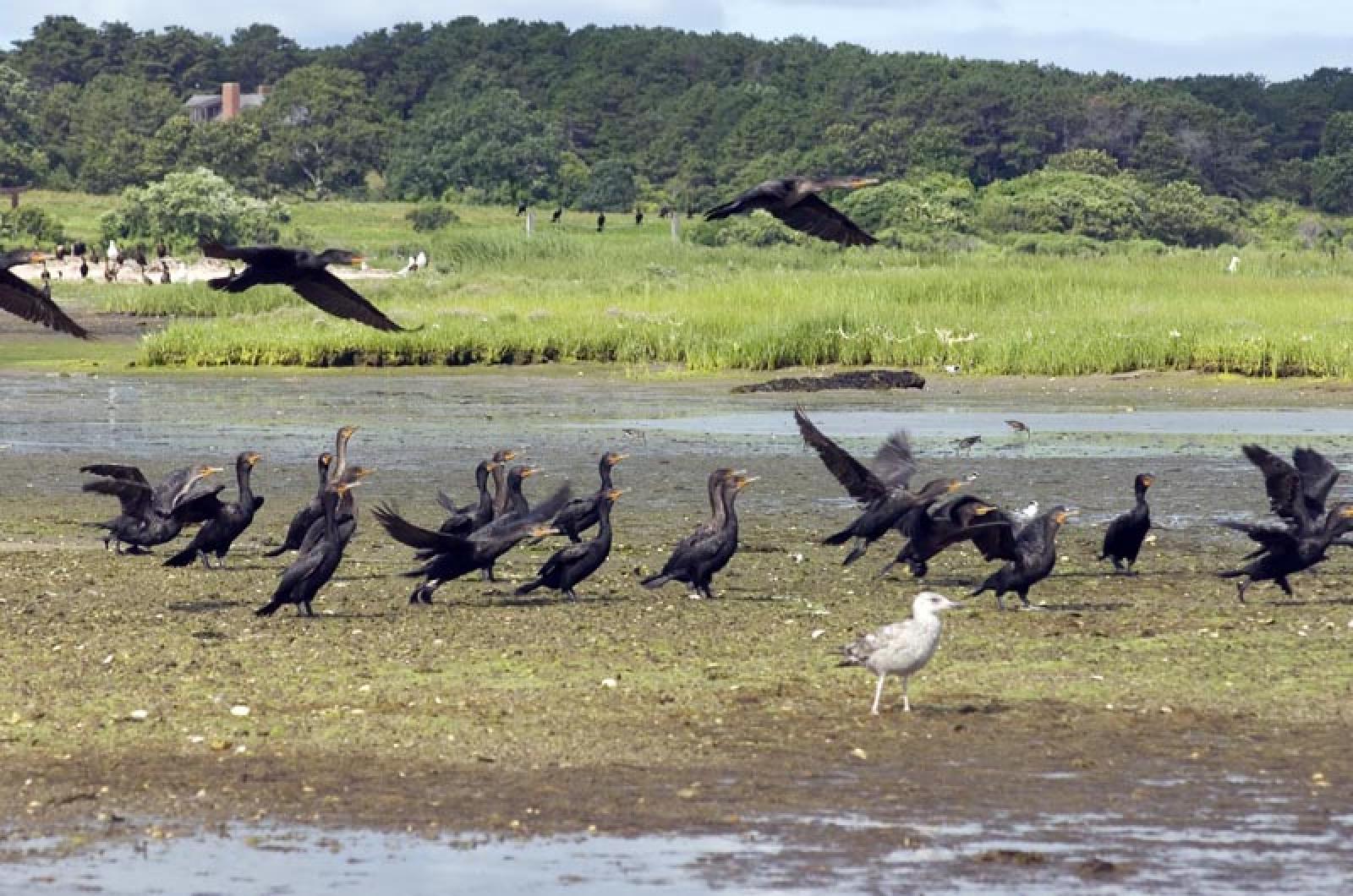Cormorants are often considered the avian rats of the coastal streams and ponds. They can be seen lining the jetties and drying their wings in wait before going heading out into the waters to compete with local fishermen.
Jack Blake, who raises cultured oysters in Edgartown’s Katama Bay, spends a lot of time thinking about ways to lessen the impact of what he sees as a menace to his business. To him, cormorants are a costly pest. Recently, he created a wiggling contraption that he calls Daddy Long Legs. Each device looks a bit like a blossoming flower made of stainless steel. Or perhaps a large spider with dozens of legs extended outward. The movement of the legs keeps the birds at bay.
Mr. Blake said he takes little credit for the success of his device.
“I got the idea from looking on the Internet,” he said. But to his credit, Mr. Blake has assembled the contraptions and recently added them to an oyster float used to raise juvenile oysters in Sengekontacket Pond. The floating nursery is anchored next to Sarson’s Island, an uninhabited strip of land where plenty of hungry birds, not just cormorants, congregate.
Black-back and herring gulls create problems for his floating nurseries. The birds defecate on the floating raft, not only bringing potential harm to the tiny bivalves in residence below, but also making the deck slippery.
Mr. Blake remembered a time early in his shellfish career, back in 1996, when he was raising quahaugs. “The gulls would harvest spider crabs, bring them to the craft and drop them. The bodies would fall into my nursery and, literally, you could have one decaying spider crab suffocating 1,000 baby quahaugs.” At the time Mr. Blake built a life-size scarecrow. “It had rain gear, with a southwester hat. A lot of people thought it was me, working late.”
The scarecrow worked fine for two weeks but then the birds caught on. “A black-back landed on the scarecrow’s head,” Mr. Blake said.
“I’ve seen people use [a plastic] owl. But I think that only works for a short time,” he said.
One of Mr. Blake’s colleagues, Roy Scheffer of Edgartown, also came up with an idea to keep birds away. His scare tactic involves little pieces of plastic blowing in the breeze.
“I’ve also tried running monofilament line overhead, but I see it as a hazard,” Mr. Scheffer said. “Monofilament worked nicely but you couldn’t always see it.”
Aquaculture shellfish farmers aren’t the only ones who have taken steps to control the impact of cormorants.
“We have a real problem,” said Bret Stearns, director of Natural Resources for the Wampanoag Tribe of Gay Head (Aquinnah). The tribe, with the support of local fishermen, has tried to protect herring, which each spring swim up the tribe’s ancient herring run. Birds feast on the anadromous fish as they make their way up the run to Squibnocket Pond.
Herring are in trouble and in need of protection, Mr. Stearns said. “You can get hundreds to thousands of herring in that small area at one time.” This gives the cormorants an easy meal.
Mr. Stearns said he has ongoing concerns about the impact the rising population of cormorants is having on finfish, including winter flounder and scup. Last October, the tribe applied for a wildlife depredation permit from the U.S. Fish and Wildlife Service. “It allows the tribe to harass, or legally take cormorants. We got it early this spring,” Mr. Stearns said.
“We have tried plastic owls,” he added. “We have tried audible screeches that sound like a cormorant in distress. In the past we’ve tried propane boomers, which the neighbors didn’t love. We have purchased a laser gun [late last year] and it is called an Avian Dissuader.”
The most effective measure to protect the fish has turned out to be monofilament line extended over the small pool. The lines have flagging tape attached.
“We now have lines that run over the top of the herring creek, so birds cannot land. They need space to land and take off,” Mr. Stearns said. “We found that the ospreys will come in but the cormorants won’t. It is interesting to see how long it [a deterrent] works.”





Comments
Comment policy »